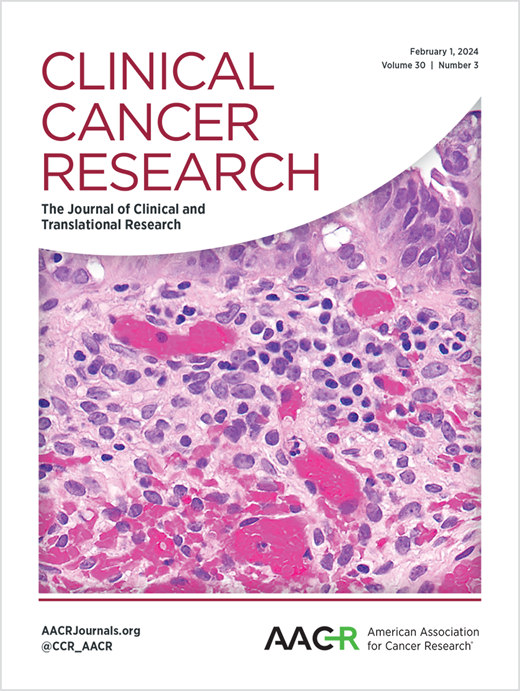Personalized MRD Assessment in Peri-surgical ctDNA for Prognostic Prediction in Hepatocellular Carcinoma
IF 10
1区 医学
Q1 ONCOLOGY
引用次数: 0
Abstract
Objective: Detecting residual disease is a critical clinical requirement in the peri-surgical management of patients with resectable hepatocellular carcinoma (HCC). Previous studies focused on specific genomic regions exhibiting limited sensitivity and failed to meet the minimal residual disease (MRD) testing threshold. We introduce a next-generation sequencing (NGS) based assay, informed by baseline samples, facilitating MRD detection in hepatectomized HCC patients and offering prognostic predictions. Experimental Design: This study involved 88 HCC patients who underwent surgical resections January 2016 to May 2016 in Zhongshan Hospital Fudan University. Tumor and normal tissue samples were collected during surgery, while plasma samples were obtained both before surgery and up to seven days post-surgery. Using an NGS-based personalized circulating tumor DNA assay, we analyzed MRD in both pre-surgical and post-surgical blood samples and the correlation with prognosis. Results: With a median follow-up period of 80.7 months, our findings demonstrated significant correlations between pre-surgical ctDNA tumor fractions, post-surgical plasma MRD status, and both recurrence-free survival (RFS) and overall survival (OS). Post-surgical MRD status emerged as the most significant risk factor for cancer recurrence (HR=2.17, 95% CI: 1.09-4.30, p=0.027) compared to other clinical characteristics in multivariate Cox regression analysis. Notably, MRD status showed potential as a prognostic indicator among clinically low-recurrent-risk patients, such as those with BCLC stage 0-A, CNLC stage I-II. Conclusion: Evaluating personalized MRD provided crucial prognostic insights into RFS and OS. It efficiently identified patients at high risk of recurrence, even among those initially perceived as low-risk cases.用于肝细胞癌预后预测的手术前ctDNA个性化MRD评估
目的:检测残留疾病是对可切除肝细胞癌(HCC)患者进行围手术期管理的一项关键临床要求。以往的研究侧重于特定的基因组区域,但灵敏度有限,无法达到最小残留病(MRD)检测阈值。我们介绍了一种基于下一代测序(NGS)的检测方法,该方法以基线样本为依据,有助于肝切除的 HCC 患者的 MRD 检测并提供预后预测。实验设计:本研究涉及复旦大学附属中山医院 2016 年 1 月至 2016 年 5 月接受手术切除的 88 例 HCC 患者。肿瘤和正常组织样本在手术过程中采集,血浆样本在手术前和手术后七天内采集。我们使用基于NGS的个性化循环肿瘤DNA检测方法,分析了手术前和手术后血液样本中的MRD及其与预后的相关性。结果中位随访时间为 80.7 个月,我们的研究结果表明,手术前 ctDNA 肿瘤分数、手术后血浆 MRD 状态与无复发生存期(RFS)和总生存期(OS)之间存在显著相关性。在多变量考克斯回归分析中,与其他临床特征相比,手术后的MRD状态是癌症复发的最重要风险因素(HR=2.17,95% CI:1.09-4.30,p=0.027)。值得注意的是,MRD状态在临床低复发风险患者(如BCLC 0-A期、CNLC I-II期患者)中显示出作为预后指标的潜力。结论评估个体化MRD为RFS和OS提供了重要的预后见解。它能有效识别高复发风险患者,即使是最初被认为是低风险病例的患者也不例外。
本文章由计算机程序翻译,如有差异,请以英文原文为准。
求助全文
约1分钟内获得全文
求助全文
来源期刊

Clinical Cancer Research
医学-肿瘤学
CiteScore
20.10
自引率
1.70%
发文量
1207
审稿时长
2.1 months
期刊介绍:
Clinical Cancer Research is a journal focusing on groundbreaking research in cancer, specifically in the areas where the laboratory and the clinic intersect. Our primary interest lies in clinical trials that investigate novel treatments, accompanied by research on pharmacology, molecular alterations, and biomarkers that can predict response or resistance to these treatments. Furthermore, we prioritize laboratory and animal studies that explore new drugs and targeted agents with the potential to advance to clinical trials. We also encourage research on targetable mechanisms of cancer development, progression, and metastasis.
 求助内容:
求助内容: 应助结果提醒方式:
应助结果提醒方式:


